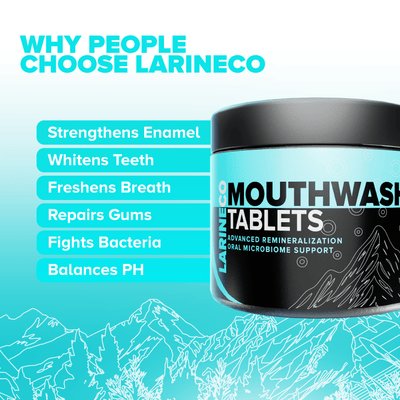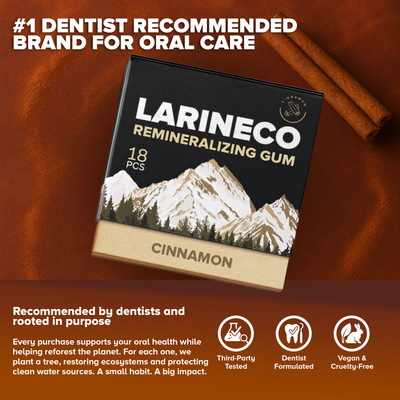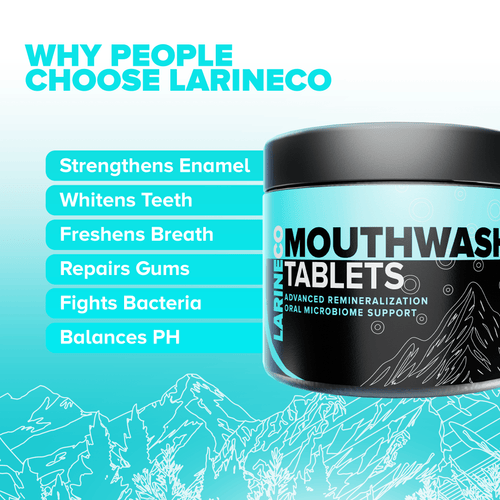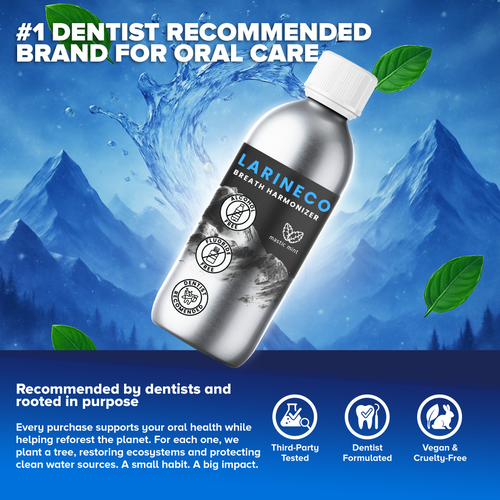The Prebiotic Effect: How Xylitol Selectively Nurtures a Healthy Oral Microbiome
Rethinking Oral Health Beyond Killing Bacteria
The Problem with the “Kill-All” Approach
For decades, mainstream oral care has focused on products that promise to kill 99.9% of bacteria. While this sounds reassuring, it ignores the complexity of the oral microbiome. Not all bacteria in your mouth are harmful. In fact, many play a protective role supporting healthy gums, regulating pH levels, and acting as the first line of defense for your immune system.
When you use harsh antibacterial mouthwashes or toothpaste, you don’t just eliminate harmful microbes. You also wipe out beneficial bacteria that maintain balance. Over time, this can disrupt the oral ecosystem, leaving room for stronger, more resistant pathogens to thrive. The result? Recurring gum issues, bad breath, and even systemic health concerns are linked to an imbalanced microbiome.
Treating your mouth like a sterile battlefield may weaken its natural defenses instead of strengthening them.
Why Balance, Not Eradication, Matters
The future of oral care isn’t about destroying all bacteria; it’s about creating balance. Just like your gut relies on probiotics for healthy digestion, your mouth needs a diverse microbiome to function optimally.
Balanced oral flora helps:
-
Protect enamel naturally by regulating acidity levels.
-
Reduce gum inflammation without over-relying on chemicals.
-
Maintain fresh breath by keeping odor-causing bacteria in check.
-
Support whole-body wellness, since oral health is closely linked to heart health, digestion, and even mental clarity.
Instead of harsh antibacterials, the focus should be on nourishing and supporting beneficial bacteria with natural compounds like xylitol, plant-based actives, and mineral-rich clays. This approach respects the oral ecosystem, creating harmony instead of destruction.
True oral health isn’t about wiping the slate clean; it’s about cultivating the right environment where beneficial bacteria can thrive, while harmful ones remain under control.
What Makes Xylitol Different
Xylitol’s Role as a Selective Prebiotic
Unlike sugar, which fuels harmful bacteria in the mouth and gut, xylitol acts as a selective prebiotic. It resists fermentation by acid-producing bacteria while supporting the growth of beneficial species. This makes it unique compared to other sweeteners or prebiotics, which often feed both good and bad microbes indiscriminately.
Feeding Good Bacteria, Not the Harmful Ones
Xylitol starves harmful bacteria like Streptococcus mutans, the main driver of cavities, while encouraging beneficial strains that promote a balanced oral and gut microbiome. By tipping the balance in favor of protective bacteria, xylitol helps reduce oral acidity, support digestive health, and maintain long-term microbial harmony.
How Xylitol Shapes the Oral Microbiome
Promoting Beneficial Bacterial Growth
Xylitol doesn’t just block harmful bacteria; it also creates an environment where beneficial bacteria can thrive. Unlike sugar, which feeds cavity-causing microbes such as Streptococcus mutans, xylitol cannot be metabolized by them. This starves the bad bacteria of their main energy source, giving an advantage to neutral or health-promoting species. Over time, this subtle shift in the balance of microbes helps the oral microbiome stabilize, encouraging diversity and resilience against disease.
Reducing Acid Production and Decay Risk
When harmful bacteria ferment sugar, they produce acids that erode enamel and trigger tooth decay. Xylitol breaks this cycle. Since bacteria can’t digest xylitol effectively, less acid is produced in the mouth. That reduction in acid translates to a lower risk of enamel demineralization, fewer cavities forming, and better long-term tooth protection. Regular xylitol use in gum, toothpaste, or lozenges acts like a daily interruption of the decay process.
Creating a Healthier pH Balance in the mouth
pH balance is critical for oral health. Acidic conditions (below pH 5.5) soften enamel and allow bacteria to thrive. Xylitol helps maintain a neutral to slightly alkaline pH, creating an environment less hospitable to harmful microbes while protecting enamel mineralization. A more balanced pH not only reduces decay risk but also supports fresher breath and a cleaner-feeling mouth. In this way, xylitol works on both the microbial and chemical levels to protect oral health.
Whole-Body Benefits of a Balanced Oral Microbiome
Your mouth is more than just the entry point for food. It’s also home to a complex community of bacteria, fungi, and other microorganisms. When this oral microbiome is in balance, it doesn’t just protect your teeth and gums; it supports your whole body. A healthy mouth can reduce the burden on your gut, regulate inflammation, and strengthen your immune system.
An imbalanced oral microbiome, on the other hand, allows harmful bacteria to thrive. These bacteria can leak into the bloodstream or digestive tract, fueling inflammation and disrupting the gut microbiome. Over time, this increases the risk of systemic conditions ranging from digestive disorders to cardiovascular disease.
A balanced oral microbiome is therefore a first line of defense for whole-body wellness.
Links to Gut and Immune Health
The oral cavity and the gut are directly connected. Every swallow transfers oral microbes and enzymes into the digestive tract. If your oral microbiome is diverse and balanced, it introduces beneficial bacteria that help maintain gut equilibrium. But if the mouth harbors pathogens, those same bacteria can disrupt gut flora, leading to dysbiosis, bloating, and impaired nutrient absorption.
This oral–gut connection also influences the immune system. Around 70% of the body’s immune cells reside in the gut, constantly interacting with the bacteria that arrive from the mouth. A healthy oral microbiome helps regulate immune responses, training the body to tolerate beneficial microbes while defending against harmful invaders. In contrast, an unhealthy oral environment may overstimulate the immune system, leading to chronic low-grade inflammation and autoimmune flare-ups.
Lower Inflammation and Systemic Protection
Inflammation is the body’s natural response to threats, but when it becomes chronic, it silently damages tissues and organs. One of the hidden sources of this chronic inflammation is the mouth. Gum disease, plaque buildup, and an imbalanced oral microbiome allow bacteria to enter the bloodstream. These bacteria release endotoxins that trigger systemic inflammation.
Keeping the oral microbiome in balance reduces this inflammatory load. Fewer harmful bacteria mean less leakage into circulation and fewer inflammatory signals sent throughout the body. This translates into a lower risk of conditions such as cardiovascular disease, type 2 diabetes, and even cognitive decline, all of which are linked to persistent inflammation.
By supporting oral balance through natural gums, saliva-friendly nutrients, and daily care, you’re not just protecting your smile. You’re giving your body systemic protection against one of the biggest drivers of modern chronic illness: inflammation.
Practical Ways to Use Xylitol for Daily Oral Care
Xylitol in Gum, Toothpaste, and Rinses
From a clinical standpoint, xylitol is most effective when used in forms that prolong its contact with saliva and oral surfaces. Chewing gum with xylitol is highly recommended because the mechanical act of chewing stimulates saliva flow while the xylitol interferes with harmful bacteria like Streptococcus mutans. Toothpaste containing xylitol adds an additional layer of cavity protection by reducing acid production during brushing. For patients with dry mouth or higher cavity risk, xylitol mouth rinses can help maintain a healthier oral environment throughout the day.
How Much Xylitol Do You Need?
Research consistently shows that a minimum of 5 grams of xylitol per day, divided into multiple exposures, is required to achieve measurable anti-cavity benefits. In practice, that might mean chewing xylitol gum two to three times a day after meals, or using a xylitol-containing toothpaste twice daily and supplementing with a rinse. The key is that frequency, small, repeated doses are more effective than a single large one, since bacteria in the mouth are constantly active.
Best Practices for Long-Term Results
Like any preventive measure, xylitol works best when used consistently over time. For patients prone to cavities, gum disease, or dry mouth, I often recommend making xylitol-based products a permanent part of their oral hygiene routine. Pairing xylitol with brushing, flossing, and a remineralizing agent such as nano-hydroxyapatite creates a synergistic effect: bacteria are suppressed, good microbes are supported, and enamel is actively rebuilt. Importantly, xylitol is safe for long-term use and has no risk of the rebound effects we sometimes see with antiseptic mouthwashes that indiscriminately kill bacteria.
In short, xylitol isn’t just a sweetener; it’s a clinically proven tool that, when used correctly, helps shift the balance of the oral microbiome toward health and resilience.
Final Takeaway
Xylitol is more than just a natural sweetener. It acts as a prebiotic, feeding beneficial oral bacteria while suppressing harmful ones that trigger cavities and gum disease. Its preventive role goes deeper. Regular xylitol use helps lower acid levels in the mouth, disrupts plaque formation, and promotes a healthier pH balance.
Larienco takes this one step further by combining xylitol with nanohydroxyapatite in its chewing gum. While xylitol works to balance the oral microbiome, nanohydroxyapatite actively remineralizes enamel, repairing micro-lesions and strengthening teeth against future damage. Together, they deliver a one-two punch: protecting your teeth, supporting your gums, and contributing to whole-body wellness.
Making xylitol part of your daily routine isn’t just about fresher breath or fewer cavities; it’s about building resilience into your oral health system. And with Larienco’s science-backed formulation, you get preventive care that feels effortless, effective, and aligned with natural biology.










